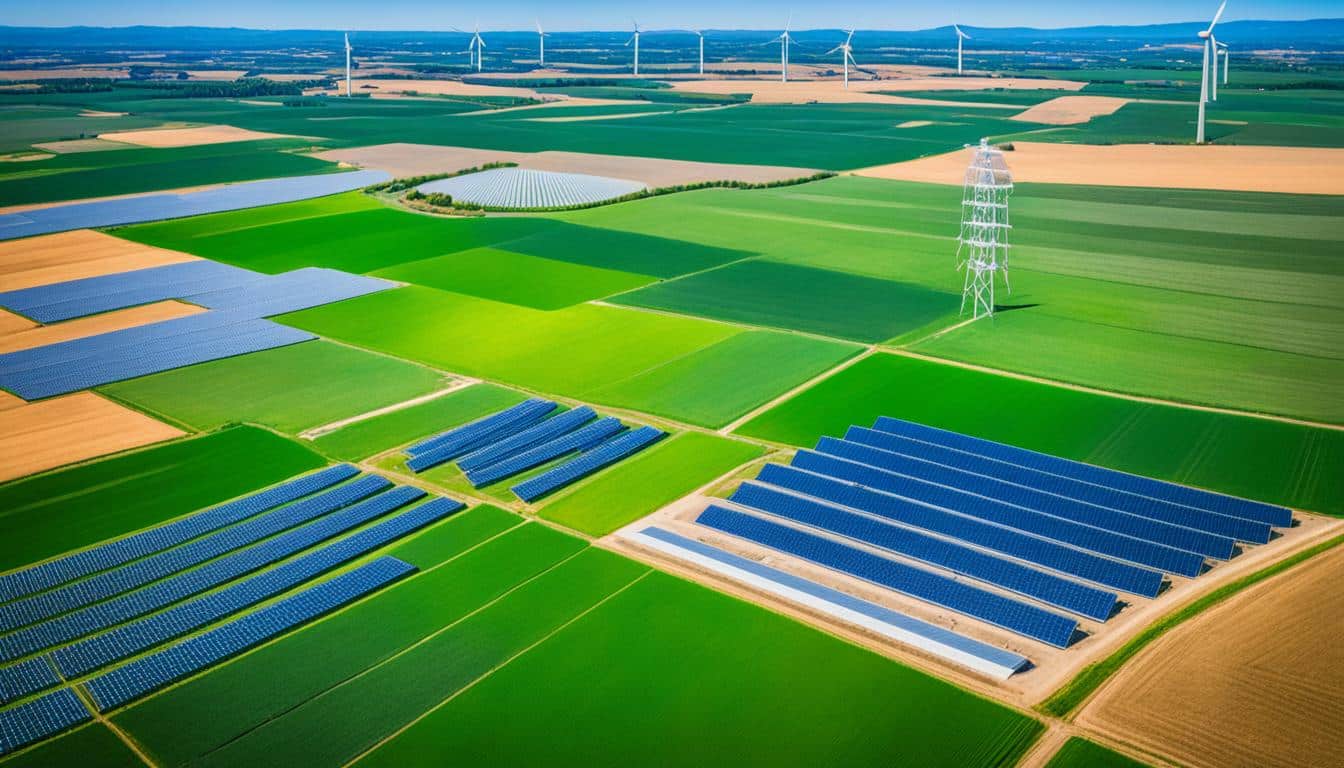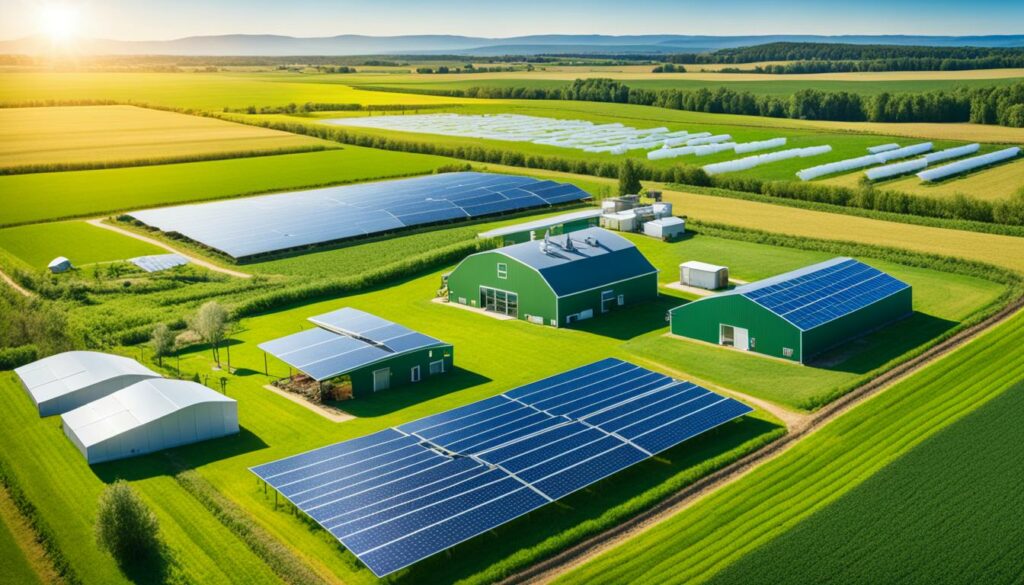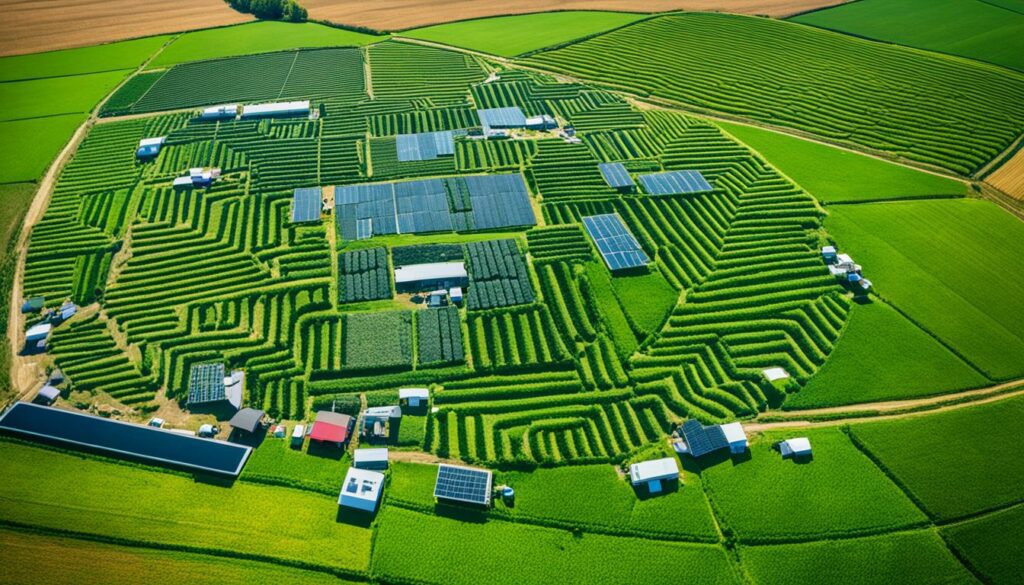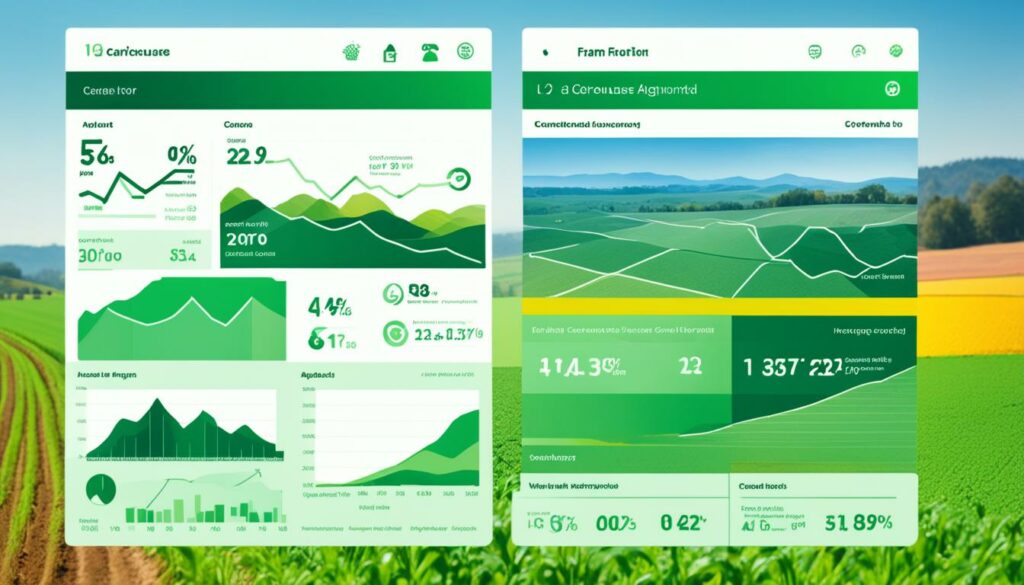Menu

Agrecalc has created over 20,000 carbon reports for more than 9,000 farms since 2007. This shows how much the focus on sustainable farming has grown. Carbon footprint calculators like these are crucial for farmers to understand their impact. The USDA’s launch of COMET-VR 2.0 also shows its support in giving farmers accurate ways to track carbon use.
The latest tool, COMET-VR 2.0, comes from Colorado State University’s work. It does more than just measure carbon sequestration. It can also help estimate how much nitrous oxide emissions can be cut. This helps farmers figure out the best conservation methods for their land.
It’s vital to know the carbon footprint of farming to understand its impact on the environment. This helps us make agriculture more sustainable. Let’s explore the essentials of this topic.
The term “carbon footprint” shows the total greenhouse gas emissions from various sources. These emissions are often measured in carbon dioxide equivalent (CO2e). In farming, knowing the carbon footprint helps us pinpoint areas where we can cut down emissions. This is key for making agriculture sustainable, especially since food production is a big source of these emissions.
Several things make up farming’s carbon footprint. Livestock, like beef cattle, producing methane is a big part. Just in 2021, beef cattle made 195 million metric tonnes of CO2 equivalent through their methane. This shows why we need to look closely at livestock’s role.
Then there’s the impact of using fertilisers and machinery. Food transportation also adds its share, making up 5% of the emissions. All these parts show how complex it is to measure farming’s true environmental effect.
Agriulture significantly affects our planet through greenhouse gases. For example, in the U.S., home electricity use’s emissions were 578.3 million metric tonnes of CO2 equivalent in 2021. This is 9.1% of the country’s emissions. In comparison, personal transport made 1.05 billion metric tonnes. Clearly, farming’s footprint is large. This means working on agriculture’s emissions is key to meeting climate goals and ensuring sustainable farming.
| Emission Source | CO2e Contribution (2021) |
|---|---|
| Food Production | 68% |
| Food Transportation | 5% |
| Livestock Methane | 195 Mt |
| Residential Electricity (U.S.) | 578.3 Mt |
| Personal Transportation (U.S.) | 1.05 Gt |
Today, there are tools to help farmers lessen their carbon impact and improve their green efforts. The Farm Carbon Calculator is one important agricultural sustainability tool. It’s useful for many different farms in the UK.

The Farm Carbon Calculator is a free tool for those in farming and gardening. It lets users see and study their carbon emissions. Users can add data on fuels, electricity, livestock, and more. With this, they calculate their overall carbon emissions and offsets in CO2e. Other tools, like Agrecalc, help farmers test out different scenarios for more sustainable farming.
These carbon footprint calculators have several upsides. They provide in-depth analysis on carbon and show what impacts the farm’s emissions. Regular updates ensure the information remains current and useful. Through these tools, farms can become more sustainable and efficient with their choices.
About 6% of total greenhouse gases in the United States come from farming. The biggest contributors are carbon dioxide (CO2) and nitrous oxide (N2O). It’s crucial to know where these emissions come from to lower them.
In field crop agriculture, the use of fossil fuels is a big source. This includes running vehicles and making fertiliser. These activities pump lots of CO2 into the air. On the other hand, managing soil also leads to a lot of nitrous oxide. Putting on nitrogen fertilisers especially increases N2O emissions.
We have several ways to reduce greenhouse gas emissions in farming. For example, there’s the carbon footprint calculator. It compares emissions from different farming methods using data from the USDA.
The Electric Power Research Institute and the National Science Foundation’s LTER Program support these tools. One of the tools, called Agrecalc, follows strict rules for measuring emissions. Since 2007, it has helped over 9,000 farms make over 20,000 reports on their emissions. This tool is in line with standards like LCA guidelines and IPCC guidelines, ensuring accurate reporting.
A farm in Scotland used Agrecalc to lower emissions from 51 kg CO2e per kg of output to 27 kg CO2e. This shows how using the right strategies can make farms both greener and more profitable.
Green farming is pivotal to long-term agriculture. The key players are organic and regenerative methods. These help cut down on harmful gases like CO2.
Organic farming relies on nature’s ways to grow plants. It avoids synthetic chemicals. This keeps the soil rich and boosts plant variety. Tools like Antithetically and COMET-VR 2.0 help measure the good it does for the planet.

Regenerative farming is about making things better, not just keeping them as they are. It focuses on improving the land. This is done through cover crops, no-till methods, and growing many different plants. These methods up the amount of good in the soil, like organic matter, and store more carbon.
Tools to calculate the effect, like carbon footprint calculators, are very useful. They show just how much regenerative farming can help our environment. These numbers are encouraging, making more people want to farm this way.
For UK farmers, the Farm Carbon Calculator does this job well, no matter the farm size or type. It looks into everything that influences carbon levels. This makes it easier for farmers to see where they can do better. Such tools are all about honesty and precision, leading to smarter choices for the planet.
| Areas Covered | Purpose |
|---|---|
| Fuels, Electricity | Track energy usage and emissions |
| Materials, Machinery | Assess input impacts |
| Livestock | Calculate methane and carbon emissions |
| Waste, Recycling | Measure waste management efficacy |
| Carbon Sequestration | Evaluate soil and vegetation carbon capture |
It’s vital for farms to use methods that store carbon. This helps the environment and brings benefits over time. Tools like Agrecalc show how important it is to manage land and store carbon wisely.
Farmers can use several ways to keep carbon. These include:
The Farm Carbon Calculator is a free tool for UK farmers. It helps keep track of things like energy use and how much carbon the farm captures. This helps farmers understand the farm’s carbon impact better.
Using carbon-storing methods has many lasting benefits for the environment. It cuts the total carbon footprint of the farm. This supports programs like DEFRA’s Future Farm Resilience, which aims for greener farming.
These methods also help reduce greenhouse gases. This fights climate change and keeps landscapes healthy for the next generation.
Studies with AgriSearch and the Beacon Farm Network show how well farms can do with carbon storing. Scottish farms have lowered their emissions. This proves the positive effect on the environment over time.
Smart tools for tracking data, such as the Farm Carbon Calculator, make sustainable farming easier. It gives detailed reports on emissions and carbon balance. This knowledge helps farmers use the best carbon-storing methods for lasting good.
The Farm Carbon Calculator is for all farm types in the UK. It includes livestock, arable, and horticulture. It helps farmers and growers understand their carbon footprints. It looks at fuels, electricity, machinery, and more.

First, you fill in your farm’s data to calculate its carbon footprint. This might take between 30 minutes to 2 hours. It covers all emission sources, like those from livestock.
First, you need to record farm details accurately. This includes fuels, electricity, and how you manage livestock. It’s important to be precise with this.
After putting in your farm’s information, the calculator shows your carbon footprint. It tells you about your total emissions and sequestration. You also learn about your carbon balance. You can trust the results’ accuracy based on a 1 to 3 scale of confidence.
Here’s a quick look at how the calculator works:
| Step | Description |
|---|---|
| Data Collection | Gather information on fuels, electricity, machinery, livestock, and other farm inputs. |
| Data Input | Enter the collected data into the carbon footprint calculator interface. |
| Calculation | The calculator processes the data to estimate carbon emissions and offsets. |
| Analysis | Review the results including total emissions, sequestration percentages, and carbon balance. |
| Action Plan | Utilise the insights to develop and implement strategies for reducing carbon footprint. |
Using the calculator helps farmers play their part in being more sustainable. They can reduce their impact on the environment.
COMET-VR 2.0 is a powerful tool for measuring and managing greenhouse gases from farming. The USDA and Colorado State University worked together to create it. This version has many features to help farmers in their journey towards sustainable agriculture.
COMET-VR 2.0 features let users check how their farm practices affect the environment. It can do things like:
These features help farmers make smart choices to cut down on greenhouse gases.
Listening to user feedback has been crucial for making COMET-VR 2.0 better. Farmers like it for being accurate and easy to use. The developers use feedback to improve the tool, keeping it up to date and helpful.
Feedback has led to better data, more farm practices included, and user-friendly designs. This active listening ensures the tool meets farmers’ needs, helping them farm in ways that are good for the planet.
COMET-VR 2.0 can look at emissions from farming, which made up 11% of the US’s total greenhouse gases in 2020. Farmers and others continue to give input, helping to improve the tool. This way, it can tackle new challenges and support sustainable farming.
Carbon footprint calculators like Agrecalc are making a big difference in farming. They help farmers improve sustainability and save money while protecting our planet.
These calculators show farmers how to spend less while reducing their carbon footprint. Since 2007, Agrecalc has helped over 9,000 farms cut costs using 20,000 carbon reports. This has led to big economic wins. It’s all thanks to over 180 expert consultants at Agrecalc.
Lessening the carbon footprint in farming is key for the Earth. Agrecalc has dramatically cut emissions on Scottish farms. It reduced carbon emissions and improved biodiversity. Thanks to scientific approval and UK standards, Agrecalc is a leader in green farming.

Studies show that cutting carbon in farming improves how efficiently resources are used. Technologies like GPS in machinery are a big help. They make sure we only use as much as needed.
Using farming methods like agroforestry and renewable energy stores carbon in the soil. This is great for soil and saves money in the long run. Agrecalc helps farmers go green, offering both economic and green benefits.
| Metric | Before Agrecalc | After Agrecalc |
|---|---|---|
| Emissions (kg/CO2e per kg of output) | 51 | 27 |
| Nitrous Oxide Emissions Reduction | – | 37% |
| Number of Carbon Reports | 0 | 20,000+ |
| Improved Biodiversity | – | Achieved |
To cut down on the carbon footprint in farming, we need to use the best methods and new farming tech. There are many ways to lower the greenhouse gas emissions from farms. Let’s look at some top methods and how tech can help.
Livestock farming is a big source of carbon emissions, with 80.31% of total emissions at Coton Wood Farm. To lower this, we should focus on better health and reproductive management for the animals. Changing what the animals eat and using better feed can also reduce the methane they produce.
Another way to fight emissions is by capturing carbon. Practices like keeping hedges, trees, and managing woods and fields are key. Testing soil carbon is vital too. It shows how much carbon is being saved and if our methods are working.
New farming tech is crucial in the fight against carbon footprints. Tools like the Carbon Toolkit help businesses check their efficiency, plan for the future, and set a starting point for cutting emissions. It even deals with how soil can help capture carbon, giving a full view of a farm’s emissions.
The Carbon Toolkit also gives a free carbon calculator for farmers. This tool helps compare the emissions from different types of crops. It’s supported by the Electric Power Research Institute and other big foundations. It’s a must-have for farmers who want to lessen their carbon impact and farm more sustainably.
| Farm | Total Carbon Balance (tonnes CO2e/year) | Carbon Balance Per Hectare (tonnes CO2e/hectare/year) | Carbon Balance Per Tonne of Product (CO2e/tonne) |
|---|---|---|---|
| Coton Wood | 4,803.79 | 15.7 | 0.89 |
Managing farm emissions relies on detailed greenhouse gas data collecting and analysing. Tools such as COMET-VR 2.0 and Agrecalc are key. They turn raw farm data into useful information. This helps the farming sector work towards being more sustainable.

To get accurate greenhouse gas data, we must know all emission sources. This includes nitrous oxide from fertilisers and methane from animals. Agrecalc helps gather this data. It looks at practices like farming methods and animal care. Using precision farming also makes data more exact. It does this by controlling how we use things like fertilisers and water.
Once we’ve collected data, we analyse the farm’s emissions. Tools like COMET-VR 2.0 and Agrecalc do this. They give detailed reports on the farm’s carbon footprint. These reports show areas where emissions are high. They also suggest strategies to lower emissions. By learning to use these platforms, farmers can make wiser choices. They can use methods like planting trees to capture carbon. Or they might switch to renewable energy to cut emissions. With precise data, farms can use resources better. This step by step reduces their carbon footprint.
| Emissions Source | Mitigation Strategy | Impact |
|---|---|---|
| Fertiliser Application | Precision Farming | Reduced Nitrous Oxide Emissions |
| Livestock Digestion | Rotational Grazing | Decreased Methane Production |
| Energy Consumption | Renewable Energy Sources | Lower Carbon Emissions |
Using tools like Agrecalc and COMET-VR 2.0, farms can work better with their data. This leads to choosing more sustainable methods. It also helps reduce greenhouse gas emissions a lot.
Farm methods are always improving with new technology. The Agrecalc agricultural tool is key for more sustainable farming. It helps measure and lower carbon footprints. This benefits the environment on farms.
Agrecalc has special features that meet strict standards. It looks at emissions in terms of CO2 equivalent (CO2e) for every unit produced. This makes it simple for farmers to watch and reduce their environmental impact.
Since 2007, Agrecalc has made over 20,000 carbon reports for 9,000 farm businesses. It also helps with benchmarking and planning different scenarios. This aids in making smart choices to cut down on pollution.
Agrecalc doesn’t just report; it also helps farmers a lot. It works with over 180 experts to support farmers. This includes work with government schemes in England and across the UK. In Scotland, it’s a big part of testing, showing it’s widely trusted.
Agrecalc is used by farmers, food companies, big farms, and policy makers. It has already helped lower emissions from 51 kg CO2e to 27 kg CO2e per output kg. Users say it has really improved their way of managing carbon output. This shows Agrecalc is really making a difference in sustainable farming.
Looking at how carbon footprint calculators are making a difference, we see great examples. For instance, at Look Family Farm in Somerset, and in the success of carbon neutral beef production. These cases show how tools like Agrecalc help farms do better in eco-friendly ways.
Look Family Farm, deep in Somerset, is a prime example. They’ve focused on improving how they use carbon and resources. In just three years, they boosted their production by nearly 50%. At the same time, they cut emissions by a third, making a big green impact.
In Scotland, Edinvale Farm has seen big changes thanks to Agrecalc. They dropped their CO2 output per kilo by a lot in three years. Alongside this, they saved more resources, fitting the Scottish Government’s plan to make beef farming greener. Their move towards carbon neutral beef is very encouraging.

These stories highlight the significant benefits of using carbon footprint calculators. Look Family Farm and Edinvale Farm’s successes prove how much we can improve by using tools like Agrecalc. They’ve shown real progress in cutting emissions and managing resources, guiding global agriculture towards a greener future.
Working out the carbon footprint in farming is key to fighting climate change. Yet, it’s hard to get it right. A big challenge is making sure the data we use is spot on. Without perfect data, our estimates could be way off. Tools such as the USAID AFOLU Carbon Calculator aim to help by squeezing out the most accurate measurements. But even the best tools struggle when the data isn’t good enough. For example, when looking at how much nitrous oxide comes from soil, the wrong numbers can really mess things up.
Collecting the right data is very important. But, different farms and places do things in their own ways. We have to track where greenhouse gases like methane and nitrous oxide are coming from. SAMPLES helps us do this with a clear plan. However, turning what we see on farms into numbers can be hard. The Winrock Plot Calculator is one way we try to figure out how much carbon is held by the soil. But, we must measure exact spots, which isn’t always easy.
Farms vary a lot, from those with a mix of plants and animals to those growing just one crop. The Cool Farm Tool and Shamba help but need to fit each farm’s unique setup. The SECTOR tool quickly looks at certain crops, like rice, but might need tweaking for other uses. By customising tools to each farm type, like the US Cropland Greenhouse Gas Calculator does, we make them more useful.
To sum up, tools like the Carbon Benefits Project and the Agro-Chain Greenhouse Gas Emissions Calculator are making farm practices better for the climate. Yet, we must sort out the issues with data and tailor them to all kinds of farming. Having the right data and tools is key. This way, we help farmers make green choices.
This calculator measures the greenhouse gas emissions that farming creates. It shows farmers their environmental impact. And it helps them find ways to lower their emissions and be more sustainable.
It helps farmers spot areas where they emit a lot. By using eco-friendly methods, they can lower their impact. This is key in fighting against climate change and making farms sustainable.
Many things add to a farm’s carbon footprint. These include how the soil is worked, the use of fertilizers, and looking after animals. Energy use and changing how the land is used also matter. They all add greenhouse gases to the air.
Definitely. These tools provide accurate data and practical advice. They help farmers cut down on harmful emissions. By following their suggestions, farms can be more Earth-friendly.
These emissions make climate change worse, which might harm farming. Crops and animals could suffer. So, it’s vital to lessen these emissions. This ensures a better future for farming.
Eco-friendly farming includes things like not using chemicals, farming in a way that helps the land recover, and using less machinery on the soil. Also, planting a variety of crops keeps the soil healthy. Such methods can help store carbon and make farming better.
Farms can store carbon by growing trees, planting certain crops in between others, not ploughing the soil, and adding natural materials to it. These methods take carbon out of the air. This helps to lower the amount of carbon in our atmosphere.
It collects information about how the farm is run, like what fuels are used, how fertilisers are put down, and looking after animals. Then, it uses a special way to figure out how much greenhouse gas the farm makes. It shows this in a detailed report.
COMET-VR 2.0 can tell you how much carbon the farm is storing. It also measures nitrous oxide, which is another type of greenhouse gas. Plus, it can look at different ways to farm and see the environmental impact. It has a system that’s easy to use and a wide range of farming tips.
These tools can help find cheap ways to cut down emissions. They also make better use of resources. And, they might help farms get rewards, like money for being good for the planet. So, farmers can be successful and green at the same time.
To reduce your farm’s emissions, focus on better fertilisers and how you look after your animals. Use ways of farming that don’t disturb the soil a lot. Add natural stuff to the soil for good health. Also, think about getting your energy from renewable sources.
Good data helps to understand where emissions come from. This way, farms can measure their impact, keep an eye on their progress, and make changes. This is vital for coming up with effective ways to be more eco-friendly.
Agrecalc lets farmers compare against what’s considered good in their line of work. They can also plan different ways to cut down on bad emissions. Plus, it gives a very detailed view of a farm’s carbon footprint. It follows strict rules for accurate info.
Agrecalc has helped farmers improve how they use resources and lower their emissions. Look Family Farm in Somerset and a beef farm in Scotland are great examples. They managed to emit less and be more sustainable with Agrecalc’s help.
It can be tricky to get the right data from different types of farms. Tools need to fit each farm’s specific needs. And it’s important to keep these tools updated with the latest farming techniques. Tackling these challenges is key to making farming less harmful to our planet.